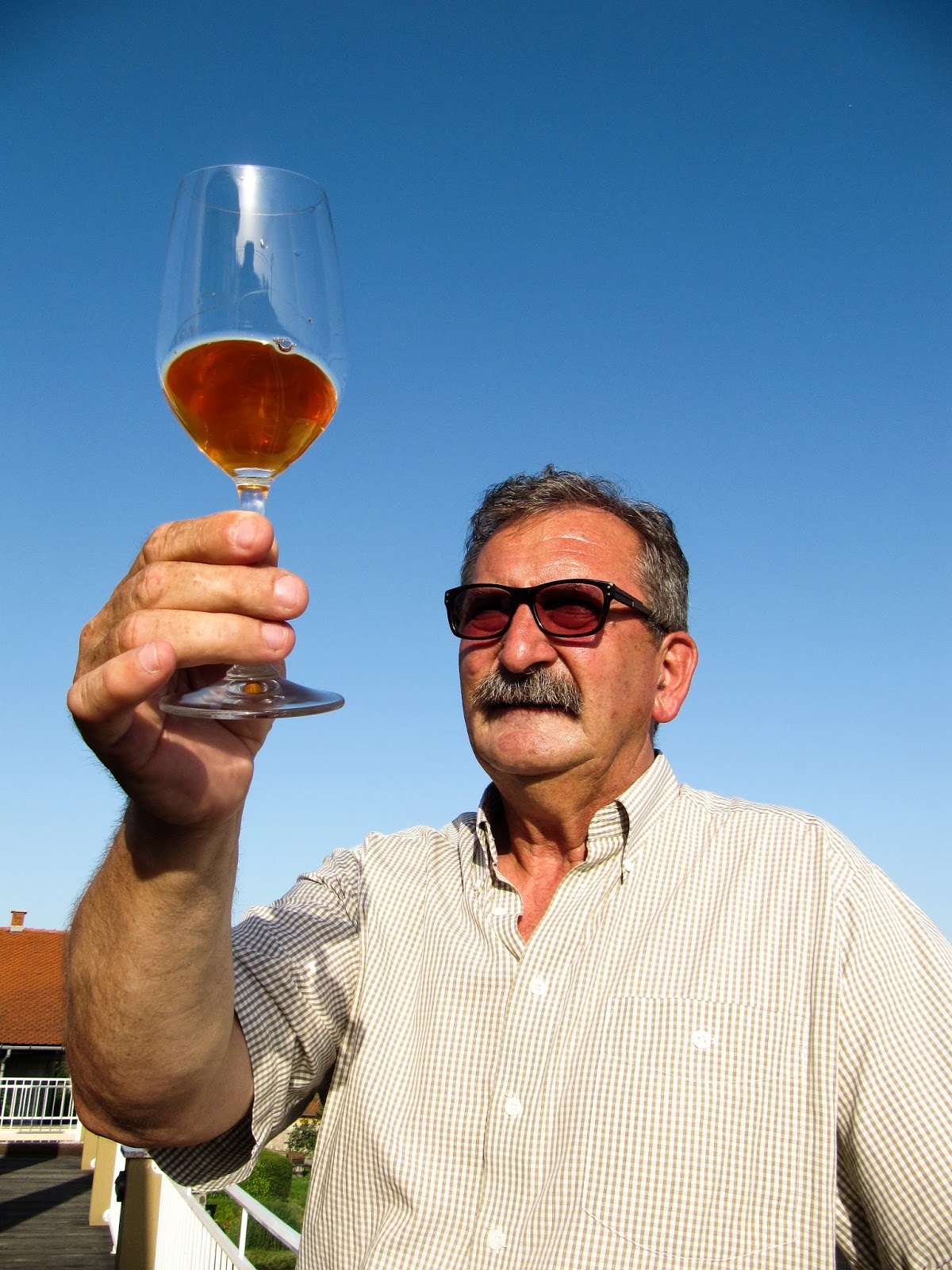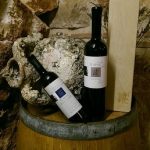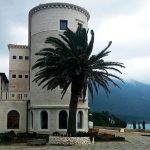
Vlado isn’t slowing down, new ideas are on the horizon, among the first is the fulfilment of his wish to acquire above-ground amphorae
Five years ago, when I first spoke to Croatian wine legend Vlado Krauthaker, I listened in disbelief his story of how he managed, several years ago, to grow Crljenak in his vineyards on the slopes of Kirindija. Vlado then confidently claimed his vineyard in Kutjevo is “the northernmost point where someone planted and succeed in making wine from the variety.”
“For Crljenak we had an agreement with the Faculty to plant 90 vines and monitor their development. Last year we made the first wine, but it was exceptionally sweet, 105 oechsl. From this year’s harvest we will make a true Crljenak on the continent. Our experience says Crljenak in Kutjevo ripens together with Merlot and it proved it has all the necessary conditions here for normal maturity. Considering 90 vines are not enough to make wine, I planted another 1.200 of them. Mind you, to verify a variety it needs to be monitored at least ten years. If at least fifty percent of the harvests are quality or high quality, then the variety is economically interesting. Crljenak will find its place here just like Merlot,” Vlado Krauthaker told me then.
Somehow at the same time I had spoken on the subject with Baranja wine champion Mišika Gerštmajer, whom I asked why he doesn’t offer any red wine. He gave an unexpected answer – he has been experimenting with Crljenak for years, which he got from Antun Plenković, but wasn’t nearly close to being satisfied with results.
“The Crljenak is driving me nuts, as in both September and November it has 18 oechsl. I’ll see next year, reduce the yield per vine to only two grape clusters, and we’ll see how it goes… In four year that I’ve been playing with it, I haven’t made nearly the kind of wine I would want it to be! On the other hand, recently I tried an excellent Chilean Cabernet Sauvignon and realised I will never make that wine. Maybe in a few years I would reach that level, but it would take me at least 20 years to achieve a continuity of the variety. And I don’t have the time for it nor do I feel like working that much,” says Mišika who considers Baranja very perspective, almost ideal for red wines.
Almost five years later Mišika is categorically convinced his Baranja story with Crljenak is over.
“There is no more doubt, I will not deal with Crljenak anymore! The entire story began as a cooperation with Ivan Pejić, who is the most deserving for Crljenak, or Tribidrag, gaining its international recognition and my good, but late friend Zlatan Plenković, who brought me 250 vines of Crljenak to plant here. I can’t say it wasn’t interesting to try planting something that is so popular in Italy and America, where the variety is known as Primitivo and Zinfandel. It was the more interesting since in America they also make a white wine from the variety, so I wanted to see how Crljenak behaves in Baranja. Unfortunately, we were not successful, Crljenak had a hard time maturing here, with up to 15 different colours per cluster during maturation,” said Mišika Gerštmajer.
Vlado Krauthaker, however, is nt giving up! Although he is convinced that “Crljenak is definitely not for Slavonia,” he still hasn’t cleared his Crljenak vineyard. Maybe he can’t make a red wine, but he can make a – rose!
“In three harvests I still haven’t made a red wine from the variety, but a rose. Regardless of the fact it flowers and matures at the same time as Merlot, the Merlot goes in a positive direction, while Crljenak stops and won’t move forward… This is clearly up to the genetic potential and chlorophyll in the leaf. It starts changing the leaf colour and there is no more photosynthesis anymore, which shows it does need a warmer climate, warmer nights which help it mature faster – it has to ripen within 15 days, while over here it wouldn’t be able to in a month. So, only rose form Crljenak,” says Vlado Krauthaker who also offered his guests on Vincekovo holiday a barrel of Crljenak rose.
Vlado will still attempt to get the maximum from the Crljenak vineyard each year, but he s convinced – “the variety is not promising for Slavonia!”
Unlike Crljenak, Vlado succeeded, among only a few beyond its homeland in north-western Italy, to plant Nebbiolo and make a good wine from it. His Nebbiolo is sold only in two restaurants in Dalmatia, Split and Šibenik, and nowhere else.
The foremost producer of Graševina claims Nebbiolo can “give plenty” even in the conditions of the Golden Valley.
“Nebbiolo can endure the winter and spring freeze, is the most resilient of all the varieties, also resistant to the autumn rot. Even in the bad years it gives good wine. It has a very long vegetation, the only problem is its weakness to downy mildew. If I decide to plant more, I need to experiment more,” added Vlado Krauthaker.
Staying true to his life motto that the point of life is the constant search for new things and new solutions, Vlado Krauthaker introduced Neuburger to his offer, an old variety which once existed in Croatian vineyards, but got lost. Not just that – from the natural crossover of Pinot Blanc and Green Silvaner from Austria, Vlado made a good export deal, as he exports his entire Neuburger production to the Czech Republic.
“There used to be, up on Plešivica and in Međimurje, several winemakers who dealt with the variety which was long present in our climate. But, I don’t know anyone anymore who works seriously with Neuburger. Considering my origins are in Međimurje, and our vineyard of three hectares used to have the variety which gave good wine, it was logical for me to plant Neuburger here in Kutjevo. And I can tell you that even in this climate I made nice results with the variety. Each year I produce and sell my Neuburger to – the Czech Republic! Specifically the Croatian Mill restaurant held by Dražen Horvat. In the Czech Republic the variety is very popular and that makes selling it there a great success! On the Croatian market the wine doesn’t generate much interest,” says Vlado.
From Blauburger, an artificial hybrid of Frankovka and Portugieser, Vlado made a wine sold completely to – Switzerland!
“The plantation of Blauburger has been significantly increased to one hectare and, not counting the sales to Switzerland, the wine is due, after 15 years of experimenting, to appear on the Croatian market. I expect from Blauburger and Neuburger to freshen up the wine offer.”
Vlado claims wine, with an appropriate presentation, is easier to sell abroad than domestically, as the restaurants here are saturated and it is hard to break through with new products. He adds “there aren’t enough professional teams in restaurants who would deal with promotion, wine presentation, not enough sommeliers…”
“Until we planted Syrah and Cabernet Sauvignon in 1995, these varieties were never recommended for the east of Croatia! Much has changed since then, large wineries have chosen to include the varieties in the assortment, but if you ask me, those varieties are still in some sort of test – how to plant them, how many vines per hectare, how much yield per vine… Still in search of many quality solutions. But regardless, Slavonia and the Danube Region have become known for the varieties and are more often a destination for those looking to buy red wine at normal prices, and that’s very important for the Croatian market Dalmatia has high prices, which is both good and bad, so we filled an open space. But, red varieties are tougher to sell on the international market, saturation is much higher there with the reds than with whites. We export red varieties to ten countries, the best being Pinot Nero as we have pushed it closest to international quality, with Mercs accepted great in Switzerland and Germany,” described Vlado.
Vlado isn’t slowing down, new ideas are on the horizon, among the first is the fulfilment of his wish to acquire above-ground amphorae, to continue his story of wines without sulphur, known as – Kuvlahke.
“I need to bring a new quality to the cellar, and nothing is better than above-ground amphorae. So far I’ve made tests in my own way with the containers I had, but with this experience I can move on and invest in containers which are better and more adequate for such wine production. Wines from the Kuvlakhe series are becoming a serious story, but are hard to sell. People are not educated enough, not many have had access to such wine. Currently I make orange wines from Graševina, Silvaner, Verduzzo and Manzoni, with longer macerations on Pinot Nero, Merlot and Cabernet Sauvignon, which gain completely new taste with such approach, especially after two years of aging. I’m moving on, constantly analysing everything I make, see everything only as wine and am not interested financially in the story,” says Vlado, adding he doesn’t consider producing Kuvlakhe a game, but a challenge and return to history some 200 years ago.
For the original and more from Vinske Priče blog on wine, click here.










